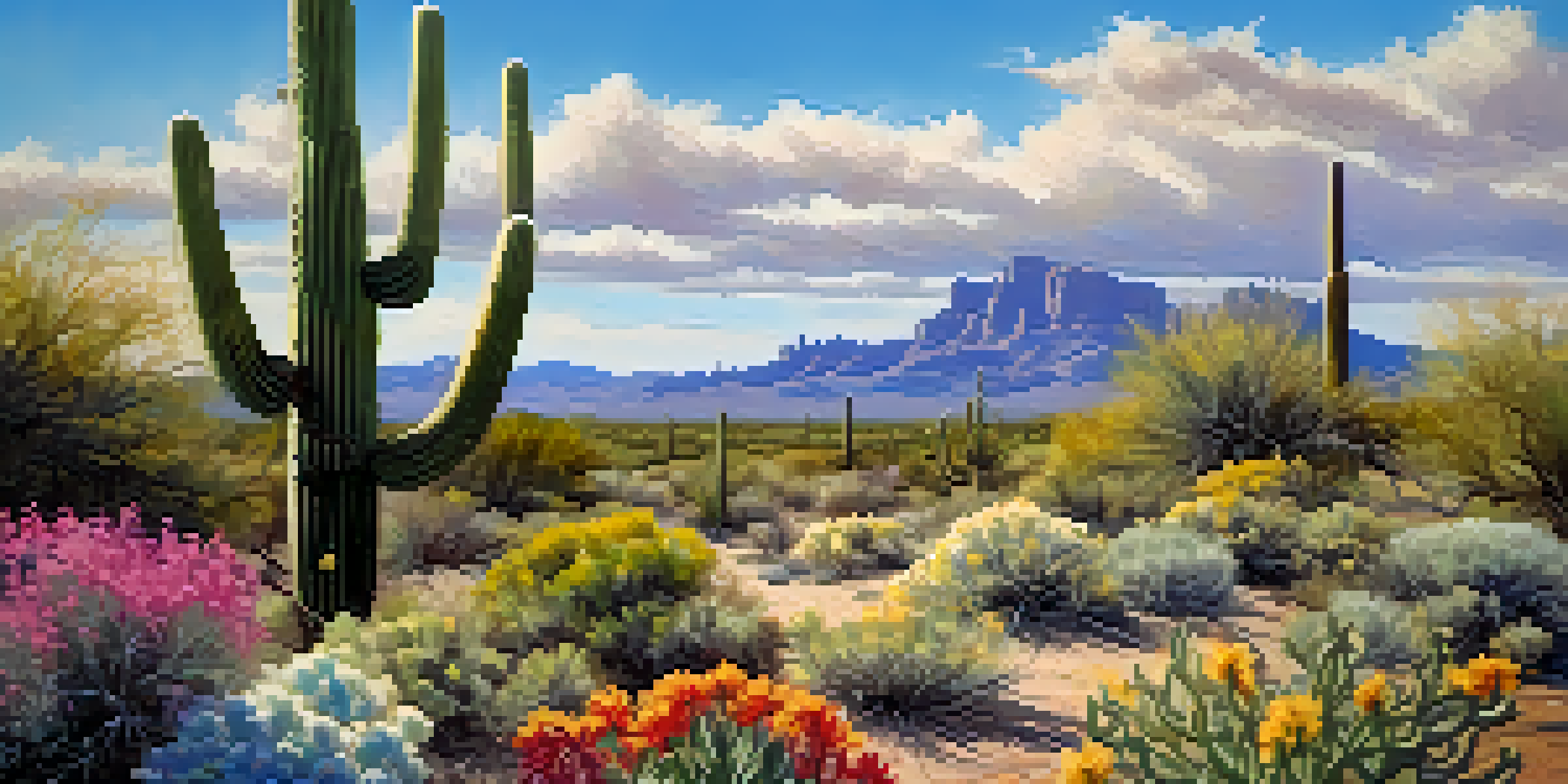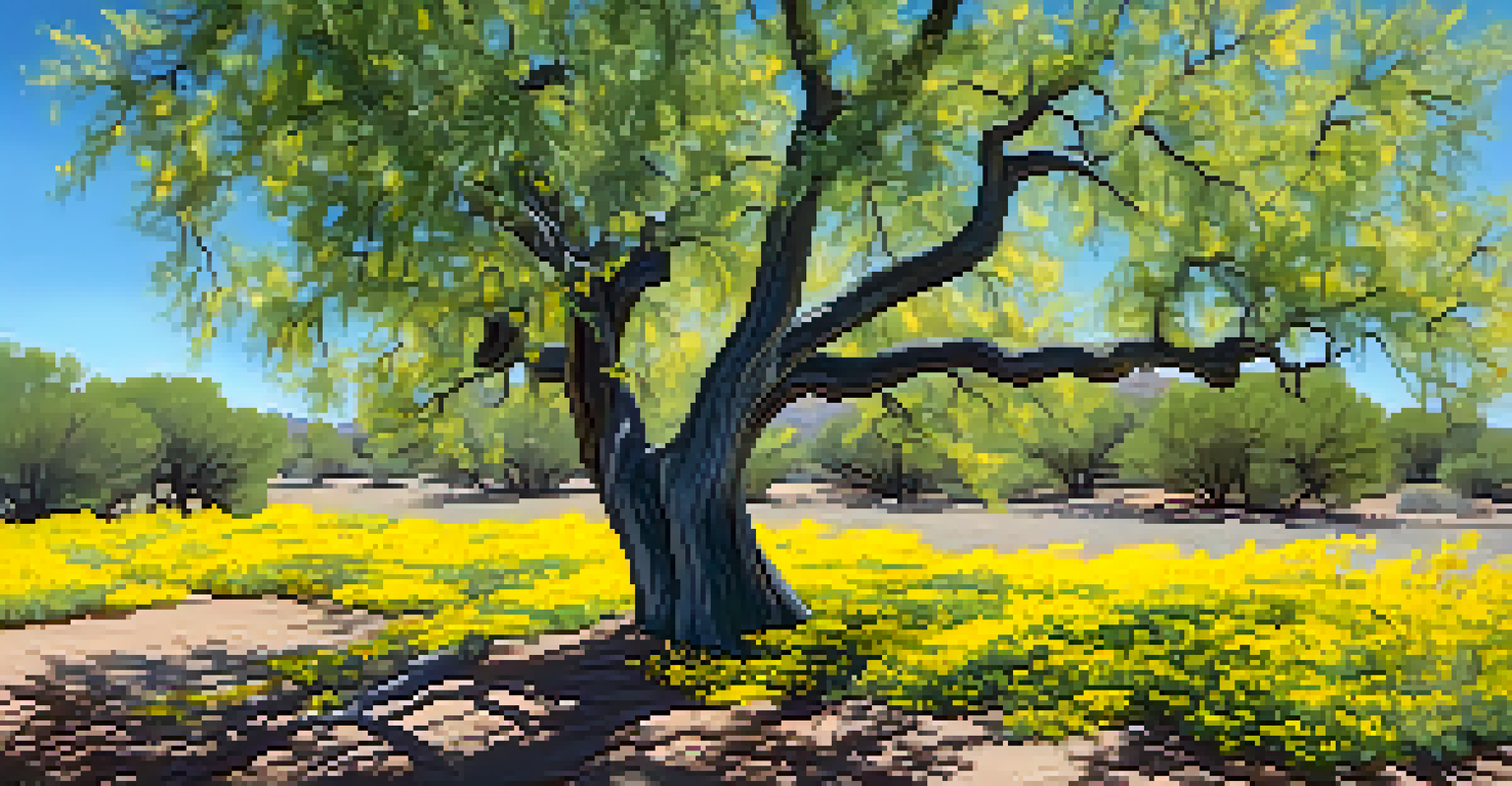Top 10 Native Plants in Scottsdale and Their Ecological Roles

1. Saguaro Cactus: Icon of the Desert
The saguaro cactus is perhaps the most iconic symbol of the American Southwest. Towering over the landscape, these cacti can live for over 150 years and grow to be as tall as 40 feet. They provide essential habitats for various wildlife, including birds, insects, and mammals, making them vital to the desert ecosystem.
The desert is a place of great beauty, but it’s also a landscape of survival and resilience.
During the spring, saguaros bloom with beautiful white flowers, which are not only visually stunning but also attract pollinators like bees and bats. These flowers eventually develop into delicious red fruits that many animals rely on for food. In this way, the saguaro cactus plays a critical role in supporting biodiversity in Scottsdale's arid environment.
Moreover, their ability to store water allows them to survive long periods of drought, showcasing their resilience. As they absorb rainwater, they help regulate groundwater levels, which benefits the surrounding flora and fauna. The saguaro is a true testament to the beauty and functionality of native plants in our ecosystem.
2. Palo Verde: The Green Tree
Palo Verde trees, known for their distinctive green bark, are another staple of Scottsdale's native flora. These trees thrive in the harsh desert climate, and their ability to photosynthesize through their bark allows them to conserve water. This adaptation makes them indispensable in maintaining a healthy ecosystem in arid regions.

In the spring, Palo Verde trees burst into vibrant yellow blooms, providing a feast for bees and other pollinators. The tree's flowers are not just beautiful; they also serve as an important food source for local wildlife. Additionally, the seeds produced by Palo Verde provide nourishment for birds and small mammals, reinforcing the tree's role in the food web.
Native Plants Support Biodiversity
Various native plants like the saguaro cactus and Palo Verde tree play crucial roles in supporting local wildlife and maintaining ecological balance.
Their shade is crucial for other plants and animals, creating microhabitats that support diverse species. By planting Palo Verde trees in gardens and landscapes, residents can contribute to the health of the local ecosystem while enjoying their stunning beauty.
3. Ocotillo: A Unique Desert Shrub
The Ocotillo plant stands out with its long, spindly branches that can reach up to 20 feet tall. Despite its appearance, this plant is not a cactus; it is a shrub that thrives in the dry desert landscape. Ocotillo is known for its incredible resilience and ability to bloom after rainfall, producing stunning red tubular flowers that attract hummingbirds.
Nature does not hurry, yet everything is accomplished.
These flowers are a vital food source for pollinators, making Ocotillo an essential player in the desert's ecological puzzle. In addition to providing nectar, the branches of the Ocotillo serve as nesting sites for birds, further enhancing its role in supporting local wildlife. Its unique structure also acts as a windbreak, helping to protect smaller plants from the harsh desert winds.
As a drought-deciduous plant, Ocotillo sheds its leaves to conserve water during dry spells, only to regrow them after it rains. This remarkable adaptation not only aids in its survival but also showcases the intricate balance of life in Scottsdale's ecosystem.
4. Desert Willow: A Beautiful Bloomer
The Desert Willow is a stunning tree that graces Scottsdale with its beautiful trumpet-shaped flowers. Blooming in the late spring and summer, these flowers range in color from white to pink and purple, attracting hummingbirds and butterflies. The tree's lush foliage provides shade and shelter, making it a favorite among local wildlife.
Beyond its aesthetic appeal, the Desert Willow plays a critical role in the ecosystem by providing food and habitat for various species. Its seeds are a food source for birds and small mammals, while the tree's dense branches offer protection from predators. This tree is a prime example of how native plants contribute to a balanced ecosystem.
Drought Tolerance is Key
Many desert plants, including Cholla cacti and Agave, have adapted to thrive in arid conditions, showcasing their resilience and importance in sustainable landscaping.
Additionally, Desert Willows are drought-tolerant, making them an excellent choice for sustainable landscaping. By incorporating this native tree into gardens, homeowners can enjoy its beauty while supporting local wildlife and conserving water.
5. Cholla Cactus: A Colorful Survivor
Cholla cacti are a diverse group of cacti that add a splash of color to the Scottsdale landscape, especially when they bloom with vibrant flowers. These cacti are known for their unique jointed structure and spiny arms that can create a stunning, almost whimsical appearance. Cholla cacti are resilient survivors, thriving in some of the harshest desert conditions.
The flowers of the Cholla cactus are not just beautiful; they also play an essential role in attracting pollinators. Many birds, bees, and butterflies rely on these blooms for food, making Cholla cacti integral to the local food web. Additionally, their fruits provide nourishment for a variety of wildlife, including small mammals and birds.
Cholla cacti also contribute to the desert ecosystem by stabilizing soil and providing shelter for smaller animals. Their ability to store water helps to regulate moisture levels in the surrounding area, which benefits other plants and organisms. This adaptability highlights the importance of Cholla cacti in maintaining ecological balance.
6. Ironwood: The Desert Giant
Ironwood trees are some of the largest and most durable trees found in the Sonoran Desert. Known for their dense, heavy wood, Ironwoods can live for over 1,000 years, providing shade and habitat for countless species. Their large canopies create a cooler microclimate, benefiting both plants and animals in the surrounding area.
In the spring, Ironwood trees produce small, fragrant flowers that attract bees and other pollinators. The seeds that follow are an important food source for birds and small mammals, further emphasizing the tree's role in the ecosystem. Ironwoods act as a refuge for various species, offering shelter from the harsh desert sun and predators.
Ecosystem Contributions of Flora
Plants such as the Desert Willow and Ironwood provide essential food sources, habitat, and shelter for various species, reinforcing the interconnectedness of the desert ecosystem.
Moreover, their deep root systems help to stabilize the soil and prevent erosion, making them essential for maintaining the integrity of the desert landscape. By planting Ironwoods, residents can contribute to the preservation of Scottsdale's natural beauty and ecological health.
7. Buckhorn Cholla: An Ecological Powerhouse
The Buckhorn Cholla is a striking cactus known for its elongated, cylindrical segments and vibrant yellow flowers. This plant thrives in the desert's challenging conditions, offering not only beauty but also essential ecological functions. Buckhorn Cholla is a crucial food source for various birds and small mammals that rely on its fruits and flowers.
Its spines provide protection for smaller animals, creating safe nesting sites and habitats. The Buckhorn Cholla also plays a role in soil stabilization, preventing erosion and promoting healthy plant growth in its vicinity. Its ability to store water enables it to survive long periods of drought, showcasing its resilience.

In addition to its ecological benefits, the Buckhorn Cholla serves as an excellent ornamental plant for desert landscapes. By incorporating this native cactus into gardens, homeowners can enjoy its unique beauty while supporting local wildlife and promoting a sustainable environment.
8. Agave: The Desert's Versatile Plant
Agave plants are well-known for their striking rosettes and sharp leaves, making them a popular choice in landscaping. However, these plants are much more than just a pretty face; they play a significant role in the desert ecosystem. Agave plants produce tall flower stalks that attract pollinators, including bees and butterflies, supporting the local food web.
Once an Agave plant flowers, it can take years to die, providing a long-lasting source of food for various animals. The leaves of Agave can also serve as a water source for thirsty wildlife, further enhancing its ecological value. Many cultures have traditionally used Agave for food, fiber, and even alcoholic beverages, showcasing its versatility.
Agave's ability to thrive in arid conditions makes it an ideal choice for drought-tolerant landscaping. By planting Agave, homeowners can create beautiful, low-maintenance gardens that contribute to the health of the local ecosystem while conserving water resources.